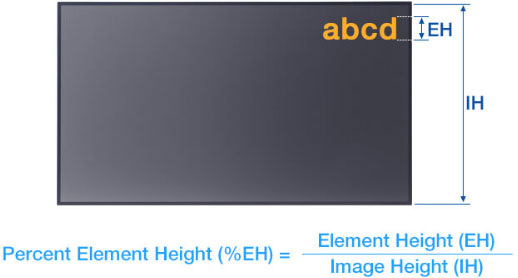Client
Research
Elements
Why Flat Panels?
Flat panel monitors (LCD, LED, OLED, et al.) can seem like attractive options when considering classroom displays. They’re bright, even in direct sunlight; offer high contrast; require little to no maintenance; and — unlike projectors — they don’t cast shadows when you stand in front of them. Some low-tech flat panel monitors might even offer a cost-saving alternative to traditional bulb projectors.
Sizing Flat Panels: Outdated Rules
The size of a flat panel monitor greatly determines its suitability as an alternative to a classroom projector. Learning how proper screen size is determined became a weeks-long project for me. I searched through numerous web-pages filled with outdated formulas, rules-of-thumb, and questionable advice to finally get to a surprisingly simple solution. During that process, I learned that these two popular rules-of-thumb are not reliable when applied to screens with HD and higher resolutions:
- The 468 rule, which states that the farthest viewer should be no more than four, six, or eight times the image height away from the screen. This rule works well enough for 1024 x 768 resolution (XGA), but not for high-definition (HD) or 4k, because it ignores the reduced element height (think font size) at higher resolutions.
- A nameless rule-of-thumb that calculates the farthest viewing distance of a display by adding 4 feet of viewing distance for every 1 foot of screen width. This rule not only fails to consider element height (like the 468 rule); it also fails to consider resolution.
Calculating Classroom Display Size: Do This Instead
Fortunately, the Audiovisual and Integrated Experience Association (AVIXA) has precise display calculators that will determine the correct screen size for two categories of viewing situations:
- Basic Decision Making (BDM): Presentations containing text and images, classrooms, boardrooms, multi-purpose rooms.
- Analytical Decision Making (ADM): Art history classrooms, medical imaging, architectural/engineering drawings, forensic evidence, image inspection.
Lost in the Math
However, AVIXA’s calculators were designed by the world’s foremost audio/visual trade association for AV professionals, so even the data required by their calculators can be intimidating and confusing for non-pros. For example, this is the formula for calculating the percent element height (%EH) required to find both the farthest viewer and the minimum image height in their BDM calculator:
 This formula will give you the exact minimum %EH, but general guidelines will save you some calculations. From Samsung’s The Best Guide to Choosing the Right Digital Signage Size:
This formula will give you the exact minimum %EH, but general guidelines will save you some calculations. From Samsung’s The Best Guide to Choosing the Right Digital Signage Size:
- 2% EH – usually sufficient for conference rooms where detailed content is disseminated over an extended period of time.
- 3% EH – this is the most common setting, usually employed where the viewers have additional clues for the information.
- 4% EH – used when there are no clues for the viewer and they don’t see the content for very long.

Most displays will look acceptable at 3% EH, which you can plug into AVIXA’s percent element height (%EH) field of their BDM calculator for a quick answer. But, there’s an even faster way.
Simplified Formulas for Calculating Classroom Screen Size
Bill McIntosh, President of BrightTree Studios, wrote How to Calculate Display Size in a Conference Room or Classroom. Straight to the point, he says:
When I first started designing audiovisual systems, I had a difficult time finding an article that helped me determine the correct display size for professional AV environments. So here it is in its simplest form: Screen Height = Distance to furthest viewer/6.”
This simple formula to find the screen size for BDM screen size, according to Bill, will “… provide almost an identical answer to the newer [AVIXA] model as long as you’re calculating for a display with HD 1920×1080 resolution, which at this time is the most common resolution”.
Bill also gives the formula for determining the proper ADM screen height of a display with HD 1920×1080 resolution: Screen height = (Vertical Image Resolution x Distance to furthest viewer)/3438.
Basic Decision Making (BDM) Formula
Screen height = Distance to furthest viewer ÷ 6
Analytical Decision Making (ADM) Formula
Screen height = (1080 x Distance to furthest viewer) ÷ 3438
Sample Results
According to AVIXA’s calculations, a 100-inch HD flat panel monitor is the minimum size for a classroom where the farthest viewer is sitting 25 feet away and seeing a “basic” view. To see an “analytical” view, that student would have to move forward a few rows, to be only 13 feet away.
At the time of this writing, institutions could pay:
- $55,000 for a commercial-grade 100-inch LED monitor,
- $5500-$6500 for a gamble on a 100-inch LED consumer model, or
- $3,500 for a 6,000-lumen laser projector that can display a 500-inch diagonal image at full HD WUXGA.
The Takeaway
Flat panel monitors offer a number of advantages over traditional bulb projectors, but for medium to large sized classrooms, projectors still offer the best results for your money.
